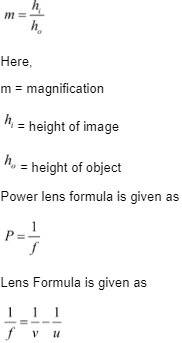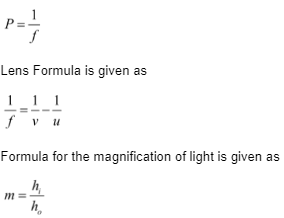One of the most intriguing ideas in ray optics is the power of a lens. In short, the ability of a lens to bend light is its strength in ray optics. A lens’s ability to refract light passing through it is directly proportional to its power. The converging ability of a convex lens is its power, and diverging ability of a concave lens is its diverging ability.
Refraction
When light travels obliquely from one medium to another medium, the direction of light propagation changes in the second medium, this phenomenon is called refraction.
Lens
A lens is a piece of glass which focuses light rays to a point or diverges light from a concentrated point. It converges or diverges with the help of dispersion. A simple lens is made of a transparent material, while the compound lens is made of multiple lenses.
Types of Lens
There are two types of lenses which are given below
- Convex Lens
- Concave Lens
Convex Lens
A convex lens has spherical surfaces that protrude in the centre. Convex lens is thicker in the middle part and thinner at the edges of the lens. This lens converges or focuses parallel rays of light which fall on its surface. Thus, a convex lens is also called a converging lens. A convex lens produces real and virtual images depending on the distance of the object from the lens.
Concave Lens
A concave lens has a spherical surface which curves inward. A concave lens is thinner in the centre and is thicker at the edges. A concave lens diverges or scatters parallel rays of light which falls on its surface. Thus, concave lens is also considered as a diverging lens. This lens always forms a virtual, upright (erect) image of a body, regardless of its distance from the lens.
Focus or Focal Point
Focal point is the point where the light coming from infinity converges after it passes through the lens. It is symbolically represented as F.
Focal Length
Distance between the pole and focal point of a lens is called focal length. It is represented as f.
There are two types of focal length which are based on the focal point.
Negative Focal Length
A negative focal length is the focal point which is on the same side of the lens as the body. Generally negative focal length is obtained in a concave lens, when the parallel light ray which travels parallel to the principal axis seems to diverge from the second focus, the focus is termed as the virtual focus and its focal length is assumed to be negative.
Positive Focal Length
A positive focal length is the focal point of the lens which is on the opposite side of the lens from the position of the object. It is generally observed in a convex lens when the parallel beam or ray of light which travels parallel to the principal axis meets actually at a point, the focus is termed as the real focus and its focal length is assumed to be positive.
Power of a Lens
In Ray Optics, the power of a lens is the ability to bend light. The greater the power of a lens, the greater the ability of the lens to refract light which passes through it. The power defines the converging power of a converging lens and the diverging power (ability) of a concave lens. The number of light curves (bends) increases with decreasing focal length. Therefore, the power of a lens is inversely proportional to the focal length of that lens. A short focal length essentially causes high optical power.
Power of a lens formula
Power of a lens formula is given as
Power = 1/(focal length)
Therefore, power of a lens is
If the focal length is in meters (m), the lens power is determined in Diopters (D) since the unit of power of a lens is the Diopter. Also note that the optical power of a converging lens is always positive, while the optical power of a diverging lens is also always negative.
Optics Formulas
Optics describes the propagation of light through the light beam or ray. The light ray in geometric optics is a tool used to approximate models of light propagation. Light rays tend to bend at the interface of two different media, where the index of refraction changes. Geometric optics gives us the rules for the propagation of light through optical devices.
Formula for thin lens is given as
Here,
f = focal length
v = image distance
u = object distance
Formula for the magnification of light is given as

Conclusion
When light travels obliquely from one medium to another medium, the direction of light propagation changes in the second medium, this phenomenon is called refraction.
A lens is a piece of glass which focuses light rays to a point or diverges light from a concentrated point.
There are two types of lenses which are given below
- Convex Lens
- Concave Lens
A convex lens has spherical surfaces that protrude in the centre.
A concave lens has a spherical surface which curves inward.
Inverse of focal length is the power of a lens.
Power of a lens is given as

 Profile
Profile Settings
Settings Refer your friends
Refer your friends Sign out
Sign out






